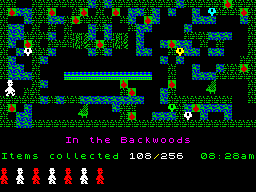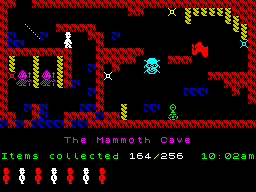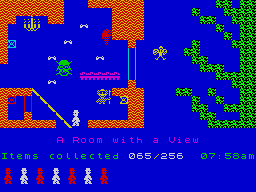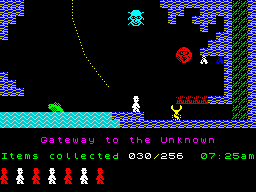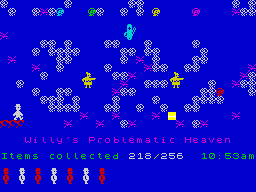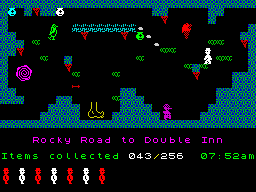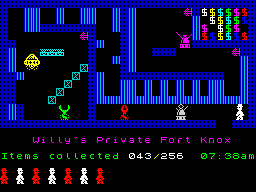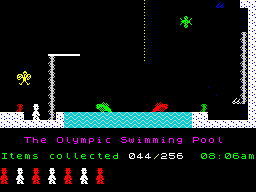-
Posts
3,218 -
Joined
-
Last visited
Everything posted by jetsetdanny
-
-
On the twelfth anniversary of the release of my first Jet Set Willy (JSW) game, "Willy's New Mansion", I am pleased to present the Special Edition (SE) of this game. The general ethos of my work on the SE was not to take anything away from the Original Edition (OE), only to add to it. Therefore, the SE is everything that the OE was, and MUCH more. The SE uses the JSW48 game engine (the one used by the original "JSW") with many enhancements, including some absolute technical novelties. The highlights of the SE include: - two additional rooms (66 in total, i.e. 10% more than in the original "JSW"); - five in-game tunes (the in-game tune is set individually in each room); - colourful arrows, including arrows that change colour in mid-flight; - "Global Seamlessness" of the screens: in every room the PAPER colour of the top two thirds of the screen (the playing area), the lower third (the status bar) and the border is the same; - time limit as a real factor which may prevent the player from completing the game successfully (unlike in the original "JSW" or the OE); the player has to choose one of four time challenge levels after the game has loaded (even the "Easy" level provides more of a time constraint than the OE or the original "JSW"!); - two separate Game Over screens: one for losing all lives, the other one for running out of time, each with a corresponding Final Screen with an appropriate text message, an animated decorative guardian and some music; - Patch Vectors (PVs) - chunks of code which produce special effects beyond what the game engine can do - applied in EVERY SINGLE ROOM of the game, producing a lot of interesting and, in many cases, never-before-seen effects, inter alia: various Screen Flash and Coloured Screen effects, a range of sound and border effects, various kinds of messages (signboards) and guardians printed on the screen, Shimmering Willy, Willy's Colour Changed on Entrance to the Room, Time Trap, the change of the in-game tune in mid-room, Swooshing Arrow & Flashing Border / Status Bar effect, Intermittent Fire Cell, numerous colour-changing guardians, killer squares flying across the screen, a moving platform which can carry Willy over obstacles, periodic reversal of the direction of the conveyor, gaps opening in walls and ramps going in both directions; - teleportation; - special effects after Willy has collected the last item, during the "toilet run", and once the game has been completed; - an "advanced" title screen; - a loading screen; - available space used virtually to the last byte; - a 130-page-long Readme file discussing various aspects of the game, including disassemblies and detailed descriptions of the Patch Vectors and the modifications applied to the game engine; - the game being Sinclair ZX Spectrum Vega/Vega+ ready (thanks to a ZXK file mapping the Vega control buttons to the ZX Spectrum keys used by the game, included in the release ZIP). The SE features also many improvements over the weak points of the OE. All unfair (and many fair) infinite-death scenarios have been eliminated, some sprites have been improved, and small modifications have been applied to room layouts, cell patterns and item distribution, both for aesthetic and functional reasons. As a result, the SE is fairer to the player, albeit somewhat more difficult than the OE. It is still far away from the most difficult games of the genre, though, and it is meant to be enjoyable to most players. The Special Edition of "Willy's New Mansion" uses various elements created by other people. Please see the "Acknowledgements and thanks" section in the Readme for details. At this point I would like to highlight my special gratitude to: - Matthew Smith, for starting it all; - John Elliott, for his excellent JSW Editor (JSWED), which was the main tool I used to create the game; - Geoff Eddy, for the PVs he created and used in his games - many of which I applied in "WNM SE", and for their disassemblies - which got me started in designing my own PVs; - Ian Rushforth (IRF) and Andy Ford (Spider) - well known on this forum - for prioritising "WNM SE" over the other projects they were working on together and for all the assistance they have given me; in particular: - Ian Rushforth for his deep, meticulous, proactive, time-consuming and wonderfully efficient involvement with the project; the final shape of the game would not be what it is without Ian's multiple contributions; even a cursory glance at the Readme will reveal the extent of Ian's involvement; - Andy Ford for his very helpful suggestions on creating the BASIC loader and the final TAP and TZX files, and for making the game Sinclair ZX Spectrum Vega-ready. The Special Edition of "Willy's New Mansion" can be downloaded from JSW Central, where you can also see the screenshots of all rooms in the game. Please download, enjoy, and send me - or post here - any comments you may have, or just let us know that you have played the game! Daniel Gromann
-
And then you could post your answer again just to make it the most recent :D .
-
Thanks, Andrew! I can see that using the "Mark Solved" option makes ONE of the answers to be Best Answer. Apparently, there cannot be TWO best answers, so I unmarked Ian's answer (I hope you won't mind, Ian :)), because they are both "best" ones for me :) .
-
From "WNM SE" Readme: "... a pointless but harmless instruction, purely to bypass the conveyor direction byte for "The River of No Return" at #C3D6 (which must have the value of #01)" "the value of #01" or "a value of #01"?
-
The same in both, I reckon, but I'll think about it when preparing the press release.
-
Thanks, Ian, I'll probably use the latter then.
-
Which sounds better: "WNM SE" was released on 10th November 2016, the twelfth anniversary of the release of the OE. or "WNM SE" was released on 10th November 2016, twelve years to the day since the release of the OE. ?
-
Thank you for your replies, Ian, which I have officially marked as "BEST ANSWERS" :) .
-
Another question: "the Air INK" or "the Air's INK"?
-
Should one say >original "JSW"< or >the original "JSW"<? For example in a sentence like: >A classic example of this in the original "JSW" is the red guardian on the left side of "Orangery"< [or whatever]. I'm asking, Ian, because in "WNM SE" Readme you didn't correct <the original "JSW"< (which actually appears a lot of times), but in a comment you added yourself, you just said, "original JSW" (no article). Any guidance on this will be appreciated :) .
-
Ian, do you feel strongly about the word "re-enter" being spelt with a hyphen, not as one (unhyphenated) word? I actually wondered about it when working on "WNM SE" Readme, and I went with the spelling in the Cambridge Dictionary, while now I can see that Oxford prefers the hyphen.
-
Andy, in "JSW 2015 Bug Fixed Edition", in the version where the in-game tune does not deteriorate, the original code which picks up the number of lives remaining (to be used by the in-game tune routine): 8B51 3A CC 85 LD A,(#85CC) was substituted with the fixed number #08, corresponding to Willy's having eight lives remaining: 8B51 3E 08 LD A,#08 8B53 00 NOP. However, in the original "JSW" that number would be #07 at the start of the game. This difference causes the pitch of the tune in the Bug Fixed Edition to be slightly higher than in the original (at the start). So the question arises whether - if you want the Bug Fix to be faithful to the original - it would not be advisable to change the value at #8B52 to #07? Just a thought :) , with thanks to Ian for drawing my attention to the discrepancy during his proofreading of the "WNM SE" Readme file :) .
-
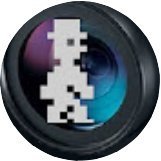
Inserting patch vectors in JSW48 games
jetsetdanny replied to jetsetdanny's topic in Designer's Lounge
Looking forward to your retirement, Andrew! A humble suggestion for your life: make a lot of money in the next 9 years, retire at 50 and spend the following 50 years designing ZX Spectrum games ;) . -

Inserting patch vectors in JSW48 games
jetsetdanny replied to jetsetdanny's topic in Designer's Lounge
A platform game, though? -

Inserting patch vectors in JSW48 games
jetsetdanny replied to jetsetdanny's topic in Designer's Lounge
Back in 2009, topping the list of projects which Andrew declared he would prioritise, was 1. the JSW64 game currently identified only as H***** . Is it the same word, by any chance? B) -
It was a pleasure :) . And this time I could only confirm that what you declared to be impossible was indeed impossible!
-
-
Why should I try again? It's possible in other rooms, but not in this one, isn't it?
-
(without having read the spoiler) I've tried it repeatedly and I don't think it's possible. The mechanism which allows Willy to perform a double jump is not there any more. Willy doesn't get hold of the rope unless he's below certain height, and it's too far away from the top to jump effectively.
-
Very interesting, Ian! Thanks for the analysis and the recording :) .
-
"Obscure, esoteric and brain-frazzling..." That's exactly what it is. It's good you realise it ;) . And it's admirable in all of its previously-mentioned qualities :) .
-
Speaking of the millenial fetish: Ian, I believe your next post will be your post # 2000. Congratulations! :D You are the most active member of this forum as far as the number of posts is concerned, apparently. Andy is in the strong second place :) .
-
Impressive! Is every single thing there unique, or do you have more than one copy of some of the collector's items?
- 9 replies
-
- manic miner
- jet set willy
-
(and 1 more)
Tagged with:

